Abstract
To study the mechanical behavior and energy evolution law of gas-filled deep coal, conventional triaxial compression experiments under different confining pressure and gas pressure conditions and cyclic loading and unloading experiments under different gas pressures were carried out. The failure characteristics and mechanical parameters evolution of two loading modes were analyzed. In addition, the energy density and ratio evolution law under cyclic loading was revealed, and based on these findings, an attempt was made to depict the relation of cumulative dissipated energy density and volumetric strain by fitting the experimental data. The results indicated that failure of coal is expressed as a single shear surface under conventional compression, while under cyclic loading mode, coal behaves with multi-fracture crushing failure. Mechanical parameters showed a trend of decay with increasing gas pressure, and that cyclic loading and unloading increases the bearing capacity of coal by 8–38%. The dissipated energy density and ratio grew significantly when coal entered the yield stage. In the compaction stage, the cumulative dissipated energy density rose with volumetric strain in the form of an exponential function, and it increased with relative volumetric strain as a power function.
1. Introduction
As an important part of the energy structure, coal resources play an irreplaceable role in industrial and social development. With increasing coal mining depth, the technical challenges and scientific problems in mining engineering increase [1,2], which hinder the safe and efficient mining as well as the utilization of deep coal resources. Due to the occurrence of deep coal in complex geological environments, disasters such as gas outbursts and rock bursts are more frequent [3,4,5], and this has attracted extensive attention from many related scholars. Almost all underground disasters are associated with deformation, damage and failure of coal, and previous scholars have carried out in-depth research on this aspect. Considering the characteristics of high in situ stress and high gas pressure in deep coal, gas–solid coupling must be taken into account in the study of coal deformation and damage. Therefore, it is of great significance to study the deformation characteristics and damage processes of coal under the combined action of external stress and gas pressure, in order to prevent underground disasters and improve the mining efficiency of deep coal resources.
In deep high-gas mines, gas is rich in coal seams. Scholars in the industry refer to deep coal that contains gas collectively as gas-filled deep coal. With an increase in gas pressure in coal, the effective stress decreases, which makes the mechanical properties and energy evolution characteristics of gas-filled deep coal different from ordinary coal. In order to study the deformation characteristics and damage behavior of coal in the mining process, related scholars have conducted a lot of research. Liu et al. [6] observed that with effective confining pressure increasing, Poisson’s ratio decreases, however, the peak strength and elastic modulus tend to increase. Xu et al. [7] revealed deformation and damage dynamic characteristics, and introduced deformation critical values to realize early warning of deformation and fracture of coal and rock materials in deep mines. Xie et al. [8] found that axial deformation, lateral deformation and volumetric deformation showed a large platform near peak stress. Zhao et al. [9] and Zhang et al. [10] fitted the relation of peak stress and confining pressure using a linear function after conducting triaxial compression tests.
Through the above conventional triaxial compression experiment research, the understanding of deformation characteristics and mechanical behavior of the coal became thorough. However, in the actual mining process, the influence of mining stress on coal is quite critical, especially cyclic loading. Based on the above research results, relevant scholars considered the mechanical behavior and damage characteristics of coal under mining stress, namely cyclic loading. Peng et al. [11] introduced a damage based on energy under cyclic loading to study damage and failure process. Wang et al. [12] found that the dissipated energy includes fracture energy and friction energy. Chen et al. [13] discovered that damage induced by energy dissipation and elastic modulus increases slowly before the reversal of volumetric strain, which then accelerates quickly. Zhang et al. [14] studied the influence of confining pressure on the energy evolution characteristics of rocks, and deduced that the confining pressure increased the energy inputting intensity. By carrying out cyclic loading and unloading experiments under different confining pressures, Wang et al. [15] drew the conclusion that after entering the yield stage, the dissipated energy density and proportion gradually increase,. Wang et al. [16] investigated mechanical properties and damage characterization of coal with axial cyclic compressive tests. Zhang et al. [17] found that the dissipated energy evolution trend with axial strain of coal behaved as S type under different confining pressures and gas pressures. Ding et al. [18] revealed the energy damage evolution characteristics of coal based on cyclic loading and unloading tests.
To sum up, researchers have studied the mechanical behavior and damage characteristics of coal under different stress paths, and made a lot of achievements. With increasing mining depth of coal resources, the characteristics of high gas pressure in deep coal seams gradually appear. In view of this feature, the conventional triaxial compression test and cyclic loading and unloading test under different gas pressures were carried out in this study, and the evolution of mechanical parameters such as the peak strength and elastic modulus of coal and the energy evolution law were analyzed. Combined with volumetric strain, the internal correlation mechanism between dissipated energy and volumetric strain was revealed.
2. Experiments
2.1. Coal Sample Preparation
The average density of coal used in the experiment was 1.38 g/cm3, and the uniaxial compressive strength was 8.8 MPa. According to the conventional triaxial compression (CTC) test regulations [19], some coal samples with a diameter of 50 mm and height of 100 mm were prepared.
2.2. Experimental Set-Up and Procedure
In order to study the influence of gas pressure and confining pressure on the mechanical properties and energy evolution of coal, the conventional triaxial compression test and cyclic loading and unloading test on coal samples were carried out on the rock triaxial test system (RTR-4600), as shown in Figure 1. The test system, produced by GCTS, has functions consisting of the uniaxial test, triaxial test, Brazilian splitting test, hydraulic fracturing test, adjusting temperature, and HDDP pulse attenuation permeation test. Its maximum axial force is 4600 kN, with a confining pressure reaching 140 MPa, and an osmotic pressure difference of 800 kPa, to a maximum of 1.5 MPa.
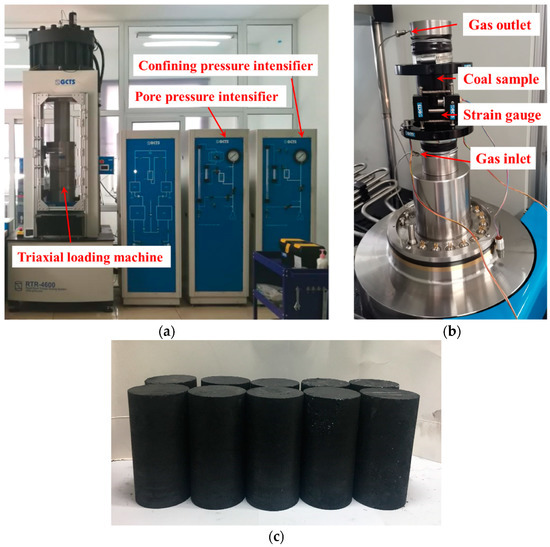
Figure 1.
Diagram of experimental set-up and coal samples. (a) GCTS triaxial testing system, (b) diagram of sample installation, and (c) coal samples.
2.2.1. Conventional Triaxial Compression Experiment Procedure
In this experiment, 40%, 50% and 60% of the uniaxial compressive strength of coal were taken as confining pressures; that is, the confining pressures were set to 3.5 MPa, 4.4 MPa and 5.3 MPa, respectively. Under each confining pressure condition, the gas pressure was set to 0 MPa, 1 MPa, 2 MPa and 3 MPa.
In order to avoid safety accidents, the confining pressure was initially loaded, and then the gas pressure was loaded in the experiment. During unloading, the gas pressure was unloaded first, and then the confining pressure. The specific experimental process was as follows: (1) the confining pressure was increased to the designed value, with a loading rate of 0.5 MPa/min; (2) the sample was vacuumized for 2 h, then filled with gas at the designed pressure and maintained at this state for more than 4 h, so that the coal sample reached adsorption saturation; it is worth mentioning that from the perspective of safety, CO2 gas was used instead of CH4; (3) axial stress was carried out, adopting a strain control mode at a rate of 0.001%/s until the residual stage of the sample.
2.2.2. Cyclic Loading and Unloading Experiment Procedure
A uniaxial compressive strength (i.e., 4.4 MPa) of 50% was used as the confining pressure, and this was unchanged during this experiment. The experiment was carried out as follows: (1) the confining pressure was loaded to 4.4 MPa using the stress-controlled mode at a speed of 0.5 MPa/min; (2) the coal sample was vacuumized for 2 h and then filled with gas with a certain pressure, which was kept this state for more than 4 h to make the coal sample reach adsorption saturation the gas pressures were set to 0, 1, 2 and 3 MPa; (3) the strain control mode was used to load axial stress, and the loading speed was 0.001%/s; the loading gradient was 0.1%, and then the axial stress was unloaded to the deviatoric stress of 1 MPa, which was followed by the next cycle until the residual strength of the coal sample remained basically stable.
The test schemes of conventional triaxial compression and cyclic loading and unloading are shown in Table 1.

Table 1.
Test schemes.
3. Results and Analysis
3.1. Analysis of Failure Characteristics
In order to compare and analyze failure mechanisms of coal under conventional triaxial compression and cyclic loading and unloading, the curves of stress–strain and failure of coal samples for different loading modes under different gas pressure conditions (the confining pressure was 4.4 MPa) are shown in Figure 2 and Figure 3.
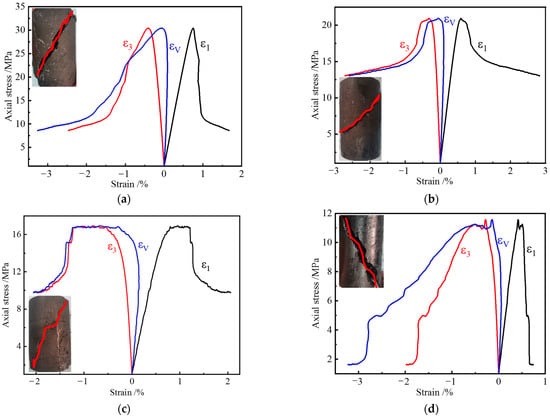
Figure 2.
Stress–strain curves and failure of coal samples under triaxial compression. (a) Gas pressure 0 MPa, (b) gas pressure 1 MPa, (c) gas pressure 2 MPa, and (d) gas pressure 3 MPa.
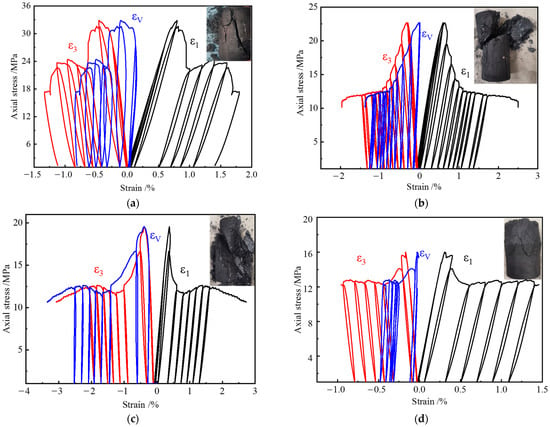
Figure 3.
Stress–strain curves and failure of coal samples under uniaxial cyclic loading and unloading. (a) Gas pressure 0 MPa, (b) gas pressure 1 MPa, (c) gas pressure 2 MPa, and (d) gas pressure 3 MPa.
The stress–strain (axial strain ε1, radial strain ε3 and volumetric strain εV) curve could be divided into four stages. (1) Compaction stage. Due to confining pressure and axial stress, original pores and fractures in coal were compressed. The volumetric strain was positive and increasing. (2) Linear elastic stage. Strain behaved a linear relationship with axial stress. The volumetric strain reached its maximum. (3) Yield stage. More microcracks were produced in the coal with increasing axial stress. In this stage, the volumetric strain εV began to decrease, even to a negative value. (4) Failure stage. The coal entered a post-peak failure stage when the axial stress reached its maximum. The number and size of microcracks increased, even fractures were connected to each other to form a fracture surface. Thus, it can be seen from Figure 2 that the coal failure formed under triaxial compression was relatively simple, and expressed as a single shear failure surface, which was at an angle of 45–60° from the horizontal direction.
Furthermore, the samples under gas pressure conditions of 0 MPa, 1 MPa and 2 MPa still had a certain bearing capacity after failure, which corresponded to the residual stage. However, when the gas pressure was 3 MPa, the damaged coal sample had almost no bearing capacity and showed brittle fracture. This is because the large gas pressure resulted in low radial effective stress, and it was not enough to limit the radial deformation of coal samples. Moreover, the lateral expansion of the coal made it lose carrying capacity completely.
Similarly to the conventional triaxial experiment, the curves of cyclic loading and unloading experiment could also be divided into four stages. The outer line of the stress–strain curve in the cyclic loading and unloading experiment was basically consistent with that in the triaxial loading test under the same conditions, which indicated that the coal had a deformation memory property.
Under the triaxial cyclic loading and unloading scheme, irreversible plastic deformation occurred at the end of each cycle. Micropores and microfractures increased, and damage accumulated gradually. When the axial stress reached its peak, the whole coal body became unstable and was destroyed. The coal in the post-peak stage still had a certain bearing capacity, and new cracks and damage still occurred inside the coal body, resulting in a more serious degree of fragmentation. Compared with conventional triaxial compression, there were many secondary fractures in addition to a shear failure surface under cyclic loading. Therefore, the failure form of coal under triaxial cyclic loading and unloading presented multi-fracture crushing failure.
3.2. Analysis of Mechanical Parameters
The failure characteristics of coal under conventional triaxial compression and cyclic loading and unloading were described and compared above. Under different gas pressure conditions, the mechanical properties of coal also changed. The effects of gas pressure on the peak strength and elastic modulus under different loading modes were analyzed separately in the following section.
3.2.1. Peak Strength
Under conventional triaxial loading conditions, when the confining pressure is equal, the higher the gas pressure, the lower the peak strength (Figure 4). This is because, on the one hand, the higher gas pressure lowered the effective circumferential stress, so the axial bearing capacity of coal samples decreased. On the other hand, when the gas pressure rose, more gas adsorbed onto the surface of the coal matrix particles and the surface bonding force became weaker, resulting in weaker carrying capacity of the coal. Eventually, the peak intensity decreased.
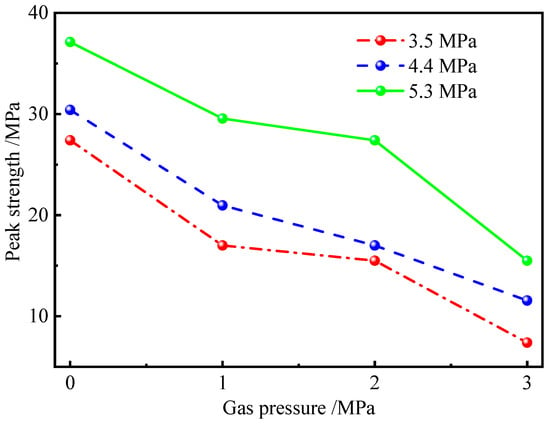
Figure 4.
Evolution of peak strength with gas pressure under different confining pressure conditions.
Under the same gas pressure, the peak strength increased as the confining pressure rose. The higher the confining pressure was, the higher the compaction degree of the coal sample became, thus increasing the bearing capacity of the coal sample.
By comparing the evolution curves of the peak strength of coal with gas pressure under conventional triaxial compression and cyclic loading and unloading conditions (Figure 5), it was found that the peak strength decreased with increasing gas pressure. The peak strength values for triaxial compressed coal were 30 MPa, 21 MPa, 17 MPa and 12 MPa, while the peak strength values were 33 MPa, 23 MPa, 20 MPa and 16 MPa under cyclic loading conditions, respectively. Under the same gas pressure conditions, the peak compression strength values of the cyclic loading and unloading test increased by 8%, 8%, 15% and 38% compared with those of the conventional triaxial test, respectively. This is because the repeated axial loading and unloading process intensified the compression and closure of the original pores and cracks inside the coal, and coal samples were more homogeneous. Under the same confining pressure, the closure degree of coal pores and microcracks under cyclic loading and unloading was higher than that under conventional triaxial conditions, and the strengthening degree of friction strength was higher. As a result, the peak strength of the sample was generally higher than that of the conventional triaxial compression.
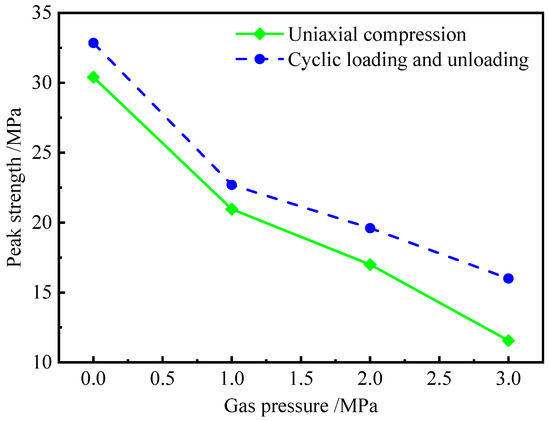
Figure 5.
Evolution of peak strength with gas pressure under different loading schemes.
3.2.2. Elastic Modulus
The elastic modulus, as an important parameter describing the mechanical properties of coal, represents the ability of coal to resist deformation. For the conventional triaxial compression test, the elastic modulus was calculated from the slope of the line segment of the loading curve.
The evolution of elastic modulus with gas pressure is shown in Figure 6, when confining pressures were 3.5 MPa, 4.4 MPa and 5.3 MPa. The elastic moduli decreased with increasing gas pressure, with values of 3.9 GPa, 3.5 GPa, 3 GPa and 2.3 GPa, respectively, when the confining pressure was 3.5 MPa. Under 4.4 MPa confining pressure, the elastic moduli were 4.3 GPa, 4.1 GPa, 3.2 GPa and 2.67 GPa, respectively. Moreover, when the confining pressure was 5.3 MPa, the elastic moduli were 4.7 GPa, 4.4 GPa, 3.5 GPa and 2.96 GPa, respectively. The reason the elastic modulus decreased with increasing gas pressure is because gas adsorption reduced the interaction force between coal particles, even increasing the distance between coal particles [20], which manifested as a reduction in the ability to resist deformation, that is, a decrease in the elastic modulus.
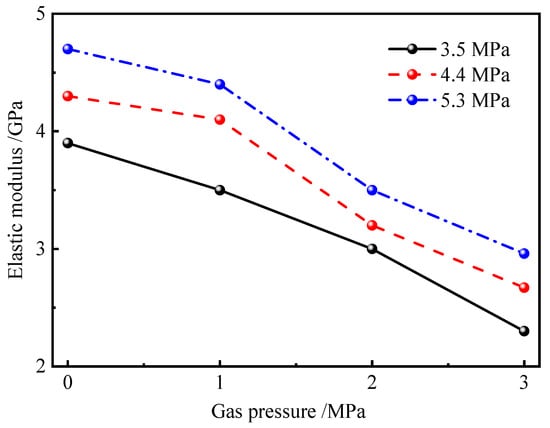
Figure 6.
Evolution of the elastic modulus with gas pressure under different confining pressure conditions.
Furthermore, under the same gas pressure, the elastic modulus increased with confining pressure. The higher the confining pressure was, the higher the compaction degree of the coal became, and the denser the coal was; hence, the resistance to deformation became stronger.
To analyze the variation in ability to resist deformation of coal with cyclic loading and unloading, the evolution of the elastic modulus with cycle index under different gas pressure is shown in Figure 7. It is worth noting that the elastic modulus of each cycle was obtained from the slope of the secant line of the unloading curve. As seen in Figure 7, the elastic modulus approximately decreased with cycle index. The reason for this was because with an increase in axial stress, the fractures in the coal gradually increased, and the damage gradually aggravated; as a result, the resistance to deformation of the coal body became weaker. However, when the gas pressure was 2 MPa, the elastic modulus increased at the beginning of axial loading, which is because under confining pressure the coal did not reach its maximum degree of compaction. When the axial stress was low, the coal was still in the compaction stage. Consequently, the elastic modulus increased in the first two cycles.
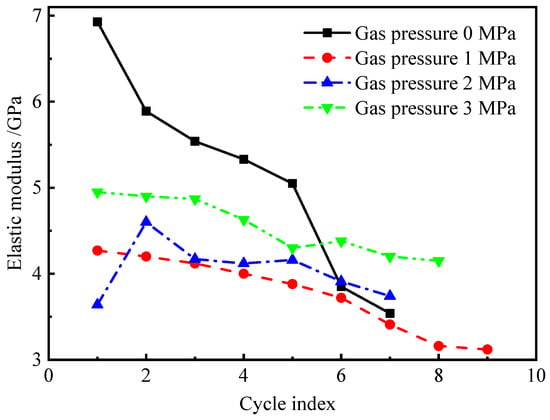
Figure 7.
Evolution of elastic modulus under different gas pressure conditions.
3.3. Energy Analysis
Fundamentally, the destruction of coal is a thermodynamic process [21,22], during which energy transfer, release and conversion exist inside the coal.
3.3.1. Energy Density
During the cyclic loading and unloading process, assuming that there was no energy exchange between the machine and the external environment, the test equipment transferred energy to the sample through mechanical work, part of which was converted into elastic energy stored inside the coal body, and could be completely released during unloading [23]. The other part was dissipated irreversibly when plastic deformation or damage occurred in coal, i.e., in the following relation:
where u, ue and ud are the input energy density, the elastic energy density and the dissipated energy density, respectively. Furthermore, they can be calculated as follows:
where ε0, ε′ and ε″ represent strain at the beginning of loading, strain at the end of loading and strain at the end of unloading, respectively.
According to the loading and unloading stress–strain curve, the input energy density, the elastic energy density and the dissipated energy density of every cycle can be obtained. As shown in Figure 8, OA is the loading curve and AB is the unloading curve. Therefore, the area of closed curve OAC represents the input energy density u, the elastic energy density ue is equal to area of BAC, and the difference between the two, that is, the area of the hysteresis loop OAB, is the dissipated energy density ud of this cycle.
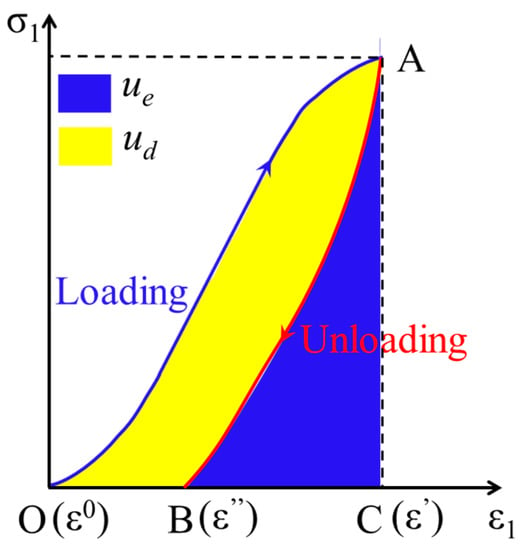
Figure 8.
Schematic diagram of energy density calculation.
The energy density evolution curves with axial strain under different gas pressures are shown in Figure 9. Furthermore, the evolution process can be divided into three stages: the compaction and linear elastic stage, the yield stage, and the post-peak stage, respectively.

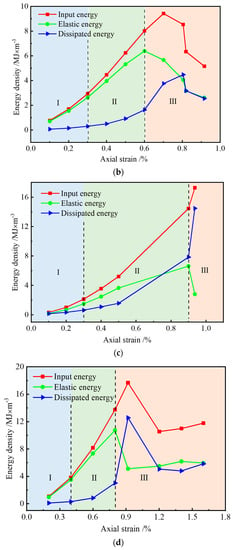
Figure 9.
The evolution of energy density with axial strain under different gas pressures (Ⅰ, the compaction and linear elastic stage; Ⅱ, the yield stage; Ⅲ, the post-peak stage). (a) Gas pressure 0 MPa, (b) gas pressure 1 MPa, (c) gas pressure 2 MPa, and (d) gas pressure 3 MPa.
The elastic energy density is basically the same as the input energy density in the compaction and linear elastic stage, and both showed an obvious gradual upward trend; meanwhile, the dissipated energy was small and almost constant. This is because original pores and fractures of coal were compressed in this stage, and most of the input energy was converted into elastic energy and stored in the coal. When the sample entered the yield stage as the axial pressure increased, an increasing number of pores and fractures were generated in the coal. As a result, the upward trend of the dissipated energy density became more highlighted. Furthermore, the elastic energy density reached its maximum at the end of the yield stage, i.e., at the peak of axial stress. In the post-peak stage, the elastic energy density decreased; however, the input energy density reached its peak in the first cycle of the post-peak stage, followed by a decreasing tendency. In addition, the dissipated energy density maintained a faster upward trend due to expansion and connectivity of fractures in failure coal. Finally, the input energy density, the elastic energy density and the dissipated energy density remained steady, where the coal entered the residual stage and reached a stable state again.
3.3.2. Energy Ratio
In order to compare the proportional distribution of elastic energy density and dissipated energy density in different stages, two dimensionless parameters, elastic energy ratio Re and dissipated energy ratio Rd, were introduced in this study, which are the ratio of elastic energy density and dissipated energy density to input energy density, respectively (Equation (3)).
The evolution of the elastic energy ratio and the dissipated energy ratio with axial strain under different gas pressures are shown in Figure 10. The evolution process of energy ratio is roughly divided into three stages: the compaction and linear elastic stage, the yield stage, and the post-peak stage.
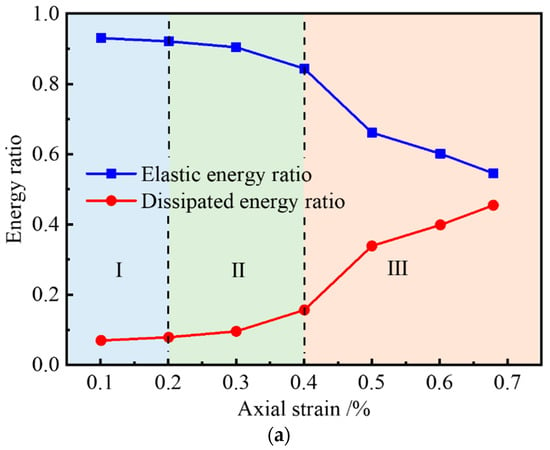
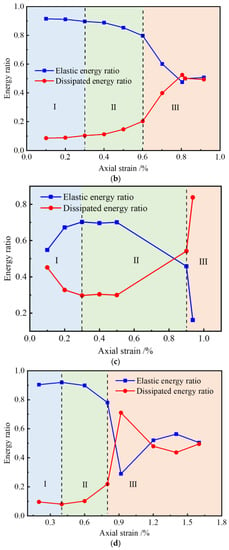
Figure 10.
The evolution of the energy ratio with axial strain under different gas pressures (Ⅰ, the compaction and linear elastic stage; Ⅱ, the yield stage; Ⅲ, the post-peak stage). (a) Gas pressure 0 MPa, (b) gas pressure 1 MPa, (c) gas pressure 2 MPa, and (d) gas pressure 3 MPa.
During the compaction and linear elastic stage, the original pores and cracks compacted, and most of the input energy was converted into elastic energy and stored in the coal body. Consequently, the elastic energy ratio was maintained at a high level, while the proportion of dissipated energy was extremely small. At the same time, it was found that when the gas pressure was small, such as gas pressures equal to 0 and 1 MPa, there was no process of the elastic energy ratio increasing, i.e., no compaction stage. This is because when the gas pressure was small, before loading axial stress, original pores and fractures in coal were close to the greatest extent. While the gas pressure was 2 or 3 MPa, the effective stress of coal was low, which was insufficient to cause compaction of coal to an extreme. Therefore, when the axial stress was applied, the coal continued to be further compacted, so the proportion of elastic energy tended to increase and reach its maximum.
In the yield stage, there were gradually more micro cracks inside coal and more input energy dissipated, resulting in more plastic deformation and damage. Therefore, the dissipated energy ratio noticeably increased.
The dissipated energy ratio rose sharply in the post-peak stage, which is because large-scale fractures were connected each other, forming macroscopic fractures, which aggravated the coal failure. The energy storage capacity of the coal significantly reduced, and the proportion of dissipated energy significantly increased, even exceeding the elastic energy ratio, which was dominant. Finally, the elastic energy ratio and the dissipated energy ratio tended to be stable because under the restriction of confining pressure, the sample formed a new stable state after failure.
3.3.3. Relationship of Cumulative Dissipated Energy Density and Volumetric Strain
Through the above analysis of energy density, it can be observed that the dissipated energy density of each cycle reflected an increment in damage in this part of the cycle. Furthermore, the damage degree of coal in the ending of every cycle could be expressed by the cumulative dissipated energy density of the previous cycles. At the same time, the volumetric strain, as a characterization of the evolution of pores and fractures in coal, was the internal cause of the damage evolution in the coal. Therefore, in order to study the evolution of cumulative dissipated energy with volumetric strain, the experimental data were expressed with appropriate functions used for fitting analysis.
During the whole cyclic loading and unloading, the volumetric strain increased with axial pressure loading in the volumetric compaction stage, because original pores and fractures were compressed, while it began to decrease as the coal entered the volumetric dilation stage; it became negative when the damage and failure extent of the coal intensified. Therefore, the relative volumetric strain was defined, in order to facilitate the analysis and summary [24]; it is the difference between maximum in the volumetric dilation point and volumetric strain , as follows:
The diagram of relative volumetric strain is depicted, taking point C in the volumetric dilation stage as an example, with the relative volumetric strain marked in Figure 11.
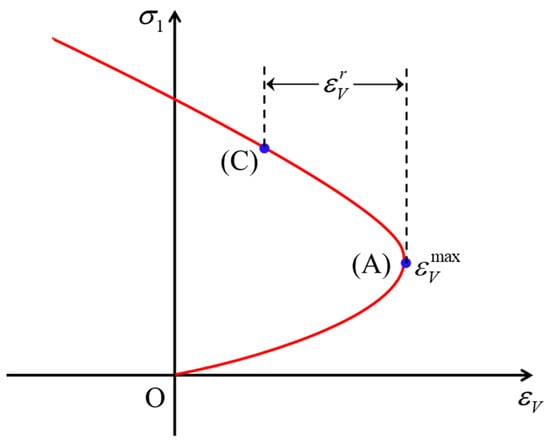
Figure 11.
Diagram of the relative volumetric strain.
The fitting result curves under different gas pressure p conditions of cumulative dissipated energy density Ud with volumetric strain in the compaction stage and relative volumetric strain in the dilation stage are shown in Figure 12.
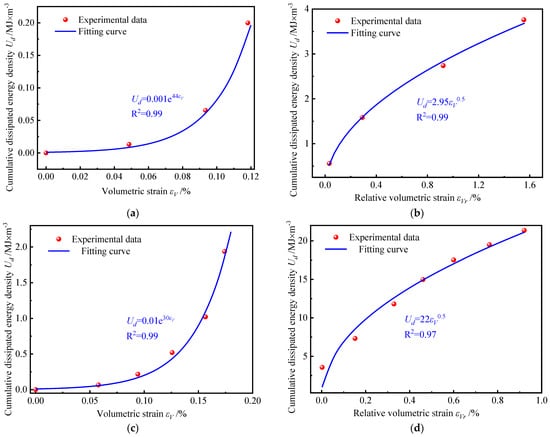
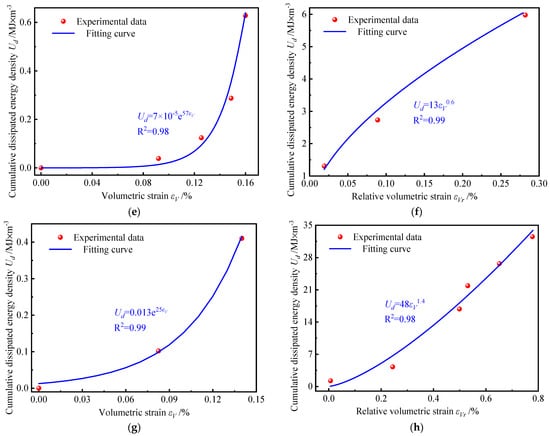
Figure 12.
The fitting results of cumulative dissipated energy density versus volumetric strain. (a) Volumetric compaction stage (p = 0 MPa), (b) volumetric dilation stage (p = 0 MPa), (c) volumetric compaction stage (p = 1 MPa), (d) volumetric dilation stage (p = 1 MPa), (e) volumetric compaction stage (p = 2 MPa), (f) volumetric dilation stage (p = 2 MPa), (g) volumetric compaction stage (p = 3 MPa), and (h) volumetric dilation stage (p = 3 MPa).
As can be seen from Figure 12, the accumulated dissipated energy density Ud increased as an exponential function with volumetric strain increasing in the compaction stage. In the dilation stage, it still showed a rising trend, as the relative volumetric strain increased in the form of a power function. Furthermore, the correlation coefficients R2 were all greater than 0.97, which illustrates the accuracy of these two functions used to describe the cumulative dissipated energy evolution with volumetric strain in the compression stage and expansion stage, respectively.
4. Conclusions
The mechanical behavior and energy evolution of gas-filled coal under conventional triaxial compression and cyclic loading and unloading experiments were studied. The main conclusions are as follows:
- The failure of coal is expressed as a single shear surface under conventional compression; meanwhile, under cyclic loading mode, coal behaves with multi-fracture crushing failure, and there are more secondary fractures than the former.
- The peak strength and elastic modulus decrease with increasing gas pressure, and cyclic loading improves the carrying capacity of coal. With progression of the loading and unloading cycle, the ability of coal to resist deformation becomes weaker and weaker.
- In the compaction and linear elastic stages, most of the input energy is converted into elastic energy and stored inside the coal. While the coal enters the yield stage, the dissipated energy density and dissipated energy ratio both show an obvious upward trend.
- There is an exponential relationship between the cumulative dissipated energy density and volumetric strain in the compaction stage, while the cumulative dissipated energy density rises with relative volumetric strain in the dilation stage in the form of a power function.
Author Contributions
Conceptualization, J.J.; methodology, Y.Z.; software, W.R.; validation, J.J. and W.R.; formal analysis, J.J.; resources, Z.D.; writing—original draft preparation, J.J.; writing—review and editing, Z.D.; visualization, G.Z.; supervision, Y.Z.; project administration, W.R. All authors have read and agreed to the published version of the manuscript.
Funding
This research received no funding.
Data Availability Statement
Not applicable.
Conflicts of Interest
The authors declare no conflict of interest.
References
- Zhou, H.W.; Xie, H.P.; Zuo, J.P. Developments in researches on mechanical behaviors of rocks under the conditions of high ground pressure in the depths. Adv. Mech. 2005, 35, 91–99. (In Chinese) [Google Scholar]
- Yuan, L. Challenges and countermeasures for high quality development of China’s coal industry. China Coal. 2020, 46, 6–12. (In Chinese) [Google Scholar]
- Li, T.; Cai, M.F.; Cai, M. Earthquake-induced unusual gas emission in coalmines-a km-scale in-situ experimental investigation at Laohutai mine. Int. J. Coal Geol. 2007, 71, 209–224. [Google Scholar] [CrossRef]
- Zhang, W.Q.; Mu, C.M.; Xu, D.K.; Li, Z.Q. Energy action mechanism of coal and gas outburst induced by rockburst. Shock Vib. 2021, 2021, 5553914. [Google Scholar] [CrossRef]
- Zhu, J.B.; Ma, B.W.; Xie, H.P.; Gao, F.; Zhou, H.W.; Zhou, C.T.; Zheng, F.R. Differences and connections between mining seismicity and coal bursts in coal mines and preliminary study on coal bursts induced by mining seismicity. J. China Coal Soc. 2022, 47, 3396–3409. (In Chinese) [Google Scholar]
- Liu, K.D. Mechanical properties of ram coal containing gas under high triaxial stress compression. Chin. J. Rock Mech. Eng. 2017, 36, 380–393. (In Chinese) [Google Scholar]
- Xu, J.K.; Zhou, R.; Song, D.Z.; Li, N.; Zhang, K.; Xi, D.Y. Deformation and damage dynamic characteristics of coal-rock materials in deep coal mines. Int. J. Damage Mech. 2017, 28, 58–78. [Google Scholar] [CrossRef]
- Xie, H.P.; Gao, M.Z.; Zhang, R.; Peng, G.Y.; Wang, W.Y.; Li, A.Q. Study on the mechanical properties and mechanical response of coal mining at 1000 m or deeper. Rock Mech. Rock Eng. 2019, 52, 1475–1490. [Google Scholar] [CrossRef]
- Zhao, Y.; Konietzky, H.; Herbst, M. Damage Evolution of Coal with Inclusions Under Triaxial Compression. Rock Mech. Rock Eng. 2021, 54, 5319–5336. [Google Scholar] [CrossRef]
- Zhang, B.A.; Li, X.M.; Zhang, D.M. Study on mechanical and permeability characteristics of containing gas coal-rock under conventional triaxial compression. Geotech. Geol. Eng. 2021, 39, 5775–5786. [Google Scholar] [CrossRef]
- Peng, R.D.; Ju, Y.; Gao, F.; Xie, H.P.; Wang, P. Energy analysis on damage of coal under cyclical triaxial loading and unloading conditions. J. China Coal Soc. (In Chinese). 2014, 39, 245–252. [Google Scholar]
- Wang, P.; Arson, C. Energy distribution during the quasi-static confined comminution of granular materials. Acta Geotech. 2018, 13, 1075–1083. [Google Scholar] [CrossRef]
- Chen, W.; Konietzky, H.; Tan, X.; Frühwirt, T. Pre-failure damage analysis for brittle rocks under triaxial compression. Comp. Geotech. 2016, 74, 45–55. [Google Scholar] [CrossRef]
- Zhang, M.W.; Meng, Q.B.; Liu, S.D. Energy evolution characteristics and distribution laws of rock materials under triaxial cyclic loading and unloading compression. Adv. Mater. Sci. Eng. 2017, 2017, 5471571. [Google Scholar] [CrossRef]
- Wang, X.Y.; Zhou, H.W.; Zhong, J.C.; Zhang, L.; Wang, C.S.; An, L. Study on energy evolution and permeability characteristics of deep coal damage under triaxial cyclic loading and unloading conditions. Chin. J. Rock Mech. Eng. 2018, 37, 2676–2684. (In Chinese) [Google Scholar]
- Wang, H.J.; Li, J. Mechanical Behavior evolution and damage characterization of coal under different cyclic engineering loading. Geofluids 2020, 2020, 881218. [Google Scholar] [CrossRef]
- Zhang, Y.; Li, B.B.; Xu, J.; Gao, Z.; Chen, S.; Wang, B. Study on triaxial compression damage evolution characteristics of coal based on energy dissipation. Chin. J. Rock Mech. Eng. 2021, 40, 1614–1627. (In Chinese) [Google Scholar]
- Ding, Z.W.; Jia, J.D.; Tang, Q.B.; Li, X.F. Mechanical properties and energy damage evolution characteristics of coal under cyclic loading and unloading. Rock Mech. Rock Eng. 2022, 55, 4765–4781. [Google Scholar] [CrossRef]
- Kovari, K. Suggested methods for determining the strength of rock materials in triaxial compression. Int. J. Rock Mech. Min. Sci. Geomech. Abstr. 1984, 15, 47–51. [Google Scholar] [CrossRef]
- Wang, P.; Wang, Z.Y. Micromechanical investigation of particle-size effect of granular materials in biaxial test with the role of particle breakage. J. Eng. Mech. 2021, 148, 04021133. [Google Scholar] [CrossRef]
- Xie, H.P.; Ju, Y.; Li, L.Y. Criteria for strength and structural failure of rocks based on energy dissipation and energy release principles. Chin. J. Rock Mech. Eng. 2005, 24, 3003–3010. (In Chinese) [Google Scholar]
- Dai, B.; Zhao, G.Y.; Konietzky, H.; Wasantha, P.L.P. Experimental investigation on damage evolution behaviour of a granitic rock under loading and unloading. J. Cent. South Univ. 2018, 25, 1213–1225. [Google Scholar] [CrossRef]
- Zhou, H.W.; Wang, X.Y.; Zhang, L.; Zhong, J.C.; Wang, Z.H.; Rong, T.L. Permeability evolution of deep coal samples subjected to energy-based damage variable. J. Nat. Gas Sci. Eng. 2020, 73, 103070. [Google Scholar] [CrossRef]
- Wang, W.; Xu, W.Y.; Wang, R.B.; Cao, Y.J.; Wang, H.L.; Feng, S.R. Permeability of dense rock under triaxial compression. Chin. J. Rock Mech. Eng. 2015, 34, 40–47. [Google Scholar]
Disclaimer/Publisher’s Note: The statements, opinions and data contained in all publications are solely those of the individual author(s) and contributor(s) and not of MDPI and/or the editor(s). MDPI and/or the editor(s) disclaim responsibility for any injury to people or property resulting from any ideas, methods, instructions or products referred to in the content. |
© 2023 by the authors. Licensee MDPI, Basel, Switzerland. This article is an open access article distributed under the terms and conditions of the Creative Commons Attribution (CC BY) license (https://creativecommons.org/licenses/by/4.0/).